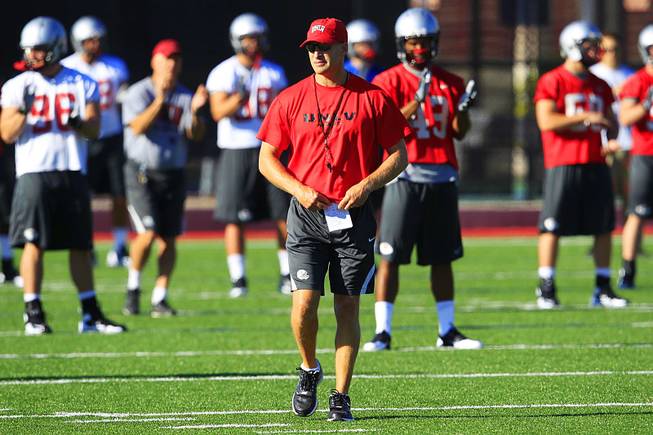
UNLV football head coach Bobby Hauck watches his team during practice at Rebel Park on Tuesday, Aug. 9, 2011.
Tuesday, Aug. 23, 2011 | 2 a.m.
Related Content
- Sophomore Caleb Herring officially named UNLV’s starting quarterback (8-21-2011)
- UNLV’s first fall scrimmage proves to be a mixed bag (8-21-2011)
- Marcus Sullivan’s star has only grown since scary injury at West Virginia (8-20-2011)
- Phillip Payne getting closer to returning from broken foot (8-20-2011)
- UNLV coach Bobby Hauck to receive 2-year contract extension (8-19-2011)
There are several reasons why Las Vegas oddsmakers set UNLV’s win total at 2.5 heading into the 2011 season.
They were 2-11 a year ago. Their schedule isn’t as tough as it was in 2010, but it’s still pretty difficult. They’re young. They have plenty of question marks.
After watching the first two weeks of the Rebels’ second fall camp under coach Bobby Hauck, I’m of this opinion: UNLV will be more competitive and exciting to watch in 2011 than it was in 2010, but is still about a year away from being a program that regularly contends for postseason berths.
But the program is headed in the right direction, there’s no question about that. Signs of it abound when you compare last year’s fall camp to the current one. Here are five of them:
-
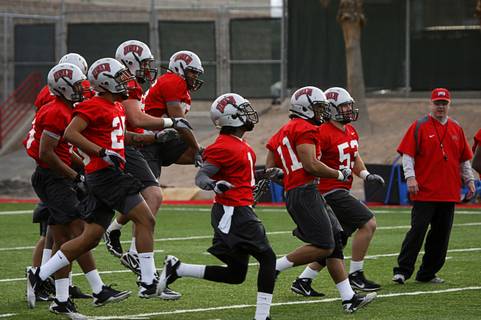
Photo by Steve Marcus1) They’re just in better shape
It’s not that guys were heaving left and right in camp last season, but the fruits of strength and conditioning coach Mike Gerber’s program are visible.
Guys who needed to add weight did so effectively, while others just look more trim and fit. There’s a noticeable lack of fat on the bodies of both UNLV’s offensive and defensive linemen.
“Absolutely it’s better,” Hauck said. “(Gerber) always feels like 18 months into a strength program, you start seeing the dividends.
“I think we’re certainly in better shape this year than we were in last year. We’re able to go longer and harder (in practice), guys are learning to play harder, fewer guys are banged up, all of those things.”
-
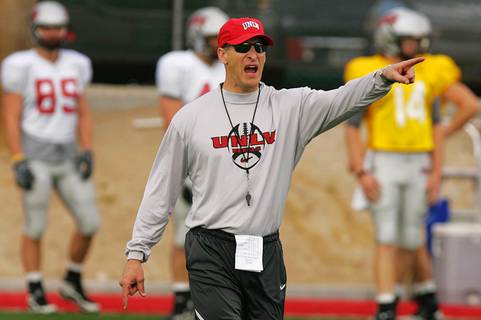
Photo by Sam Morris/Las Vegas Sun2) More productive practices
On top of being able to push guys who are in better shape to practice longer, Hauck can also conserve some energy of his own on the practice field.
“We are spending more time coaching technique and scheme rather than just attitude and effort,” Hauck said. “A lot of that is more of a mainstay now, day in and day out, which is good.”
Hauck didn’t have players from the Mike Sanford era necessarily rebelling against him openly last fall, but he certainly had some hurdles to clear in terms of getting guys to fall in line with his approach. His style at Montana was hard-nosed and disciplined with a strong hint of old-school philosophy.
It’s beginning to show within the current personnel. There’s still a ways to go in that department, but not as much as there was a year ago.
-
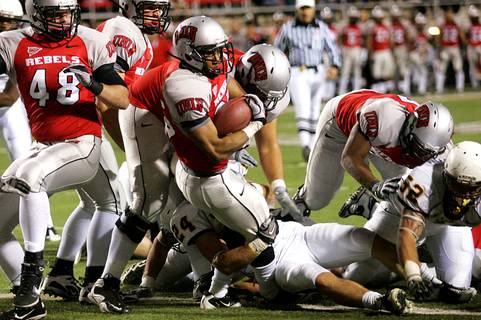
Photo by Sam Morris3) Efforts on the recruiting trail are showing
It was going to be hard for Hauck and his staff to come into the UNLV program last year and immediately target top-flight prep recruits and reel them in.
Instead, they followed a more challenging pattern: Comb the junior college ranks for guys who can play right away, then take high school prospects who need some work — especially those in their backyard — but could develop into strong college players.
Among linebacker Princeton Jackson, cornerback Ken Spigner and safety Dre Crawford, Hauck hauled in three juco prospects this year who will likely see serious playing time right from go in 2011 and help shore up a defense that was thin in numbers last season. Several more could see the field, too.
Meanwhile, some of the under the radar high school seniors the staff saw potential in a year ago are now looking like key contributors.A good example is sophomore running back Tim Cornett, who led the Rebels in rushing last year with 546 yards. Now, he’s transformed himself into more than just a speedster who can rip off big runs. He bulked up, learned how to run between the tackles more effectively and has the look of a complete back.
The next to emerge could be redshirt freshman left tackle Cameron Jefferson. He was raw coming into UNLV a year ago. He only played two seasons of football at Desert Oasis High, tipped the scales at just over 260 pounds and had rough technique. Now, he’s up to 290 pounds while maintaining his above-average athleticism and looks much more comfortable at the position. He’ll learn on the fly this season and likely will endure some visible growing pains, but expect him to anchor UNLV’s offensive line for several years.
There will likely be several stories similar to Jefferson’s as the staff continues to look for potential rather than polish on the recruiting trail. And landing some of those guys in both the 2012 and 2013 classes now becomes a bit easier that there’s stability at the top of the program, with Hauck having agreed last week to an extension through the 2014 season.
-
Photo by Sam Morris4) Stability at the quarterback position
In a move that was surprising to very few, Caleb Herring was officially named UNLV’s starting quarterback on Sunday.
Yes, he earned the job so far this fall camp by showing the best knowledge of the Rebels’ offense and by being the most consistent performer of those competing for the gig.
But, really, he also earned the job last year. Aside from gaining valuable experience by appearing in eight of UNLV’s 13 games, he successfully made the difficult transition from being a quarterback in the shotgun spread offense to a guy who can operate from either the shotgun or under center.
He was successfully reprogrammed, and now has both the sound and the look of a guy who is more confident in what he’s doing. Add in the fact that he’s only a sophomore, and, barring injury, UNLV could have some stability at football’s most important position for the next three seasons. As many who follow UNLV football know, that hasn’t been the program’s strong suit in the past decade or so.
-
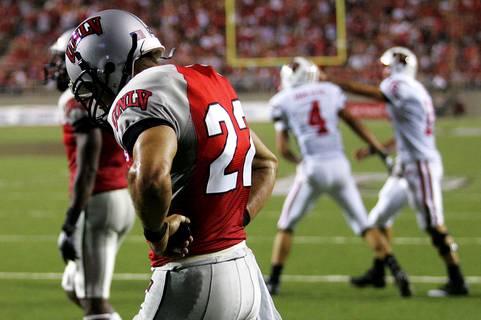
Photo by Sam Morris/Las Vegas Sun5) Then there’s scheduling
OK, so this one is not related to training camp. But the proof should show up on paper in the future.
Last season’s schedule was originally set up by former athletic director Mike Hamrick with the idea that the program would be peaking under Mike Sanford and be ready to step up to bigger challenges (and paydays). Instead, in a transition year under a new head coach, the nonconference slate included Wisconsin, West Virginia, Nevada-Reno, Hawaii and Idaho. Mix in BYU, TCU, Air Force, Utah and San Diego State in the conference portion of the slate, and, well, Hauck was in a tough spot.
So expect the philosophy to change some in the coming years. The hope for UNLV is that while the quality of the personnel increases, the level of competition from outside of the Mountain West Conference will even out some.
For example, next season, UNLV will host Minnesota and Washington State — two lower-ranking teams from BCS conferences — while traveling to face Utah State and Louisiana Tech. All four could be looked at as games the Rebels will have a chance to win.
The idea of playing the likes of Wisconsin and West Virginia might seem more sensible if the upward trend continues.
But not right now.
“(In 2010) we played a Top-15, Top-20 schedule in the country, were the only non-BCS school to play a schedule like that, and the reality of it is if we want to turn this around, we have no business playing the schedule we played last year,” he said. “It makes zero sense. It just doesn’t.”



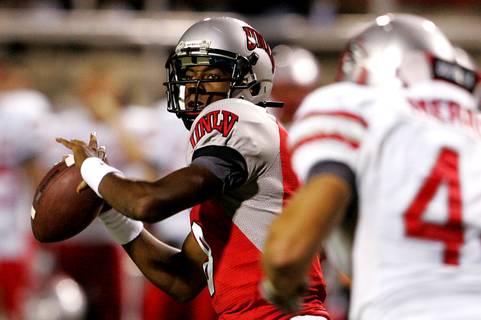


Join the Discussion:
Check this out for a full explanation of our conversion to the LiveFyre commenting system and instructions on how to sign up for an account.
Full comments policy